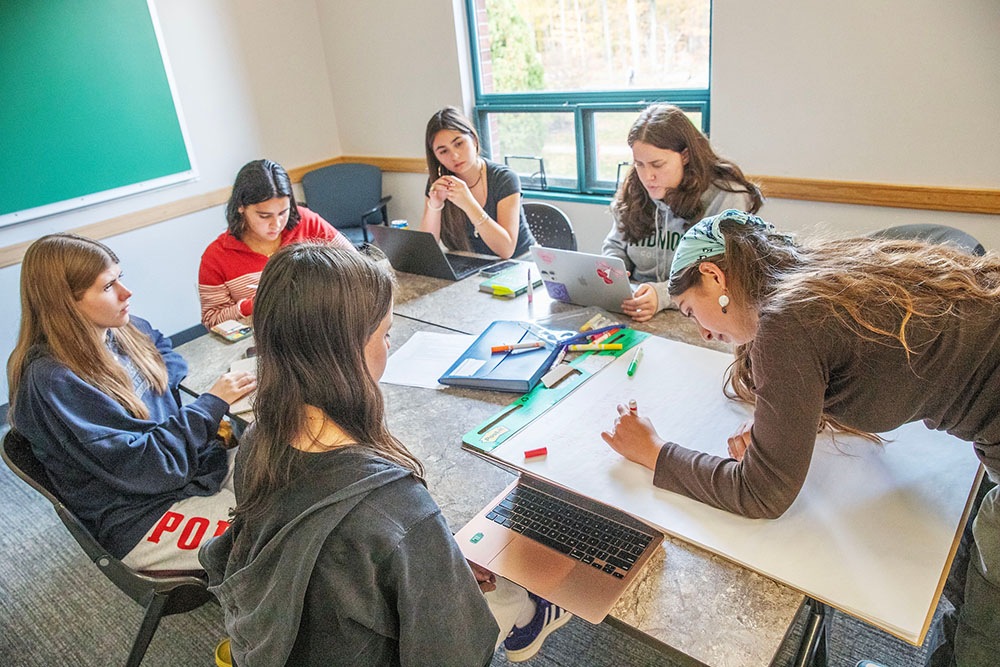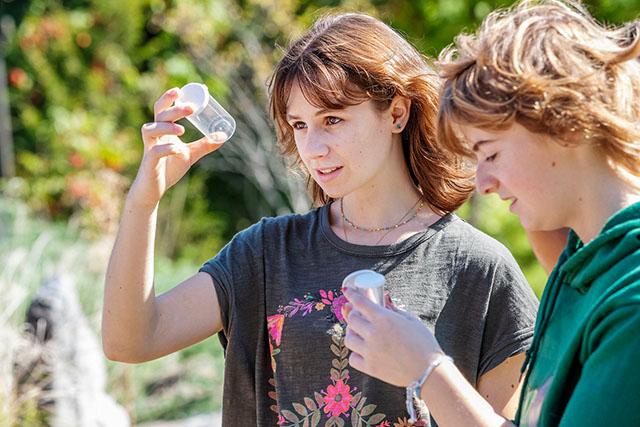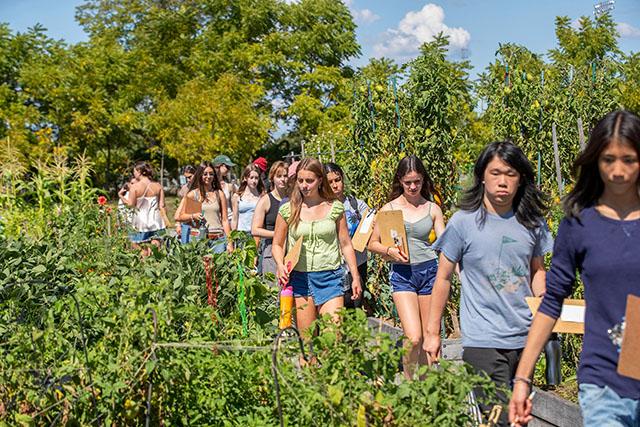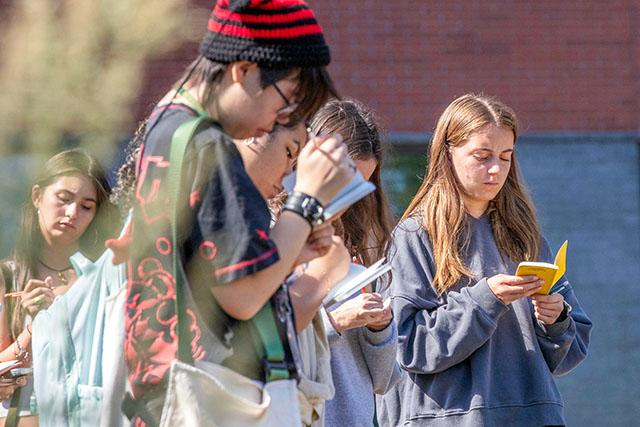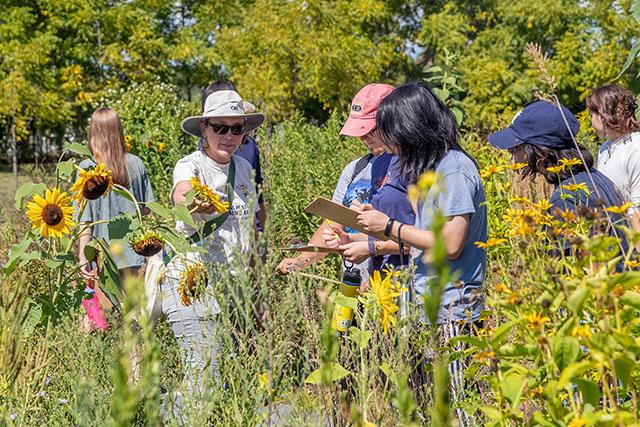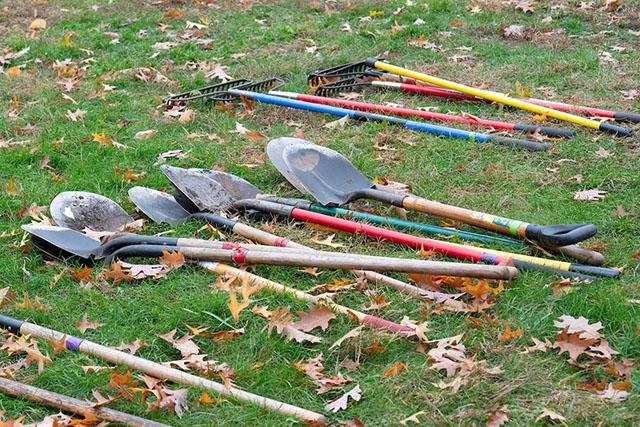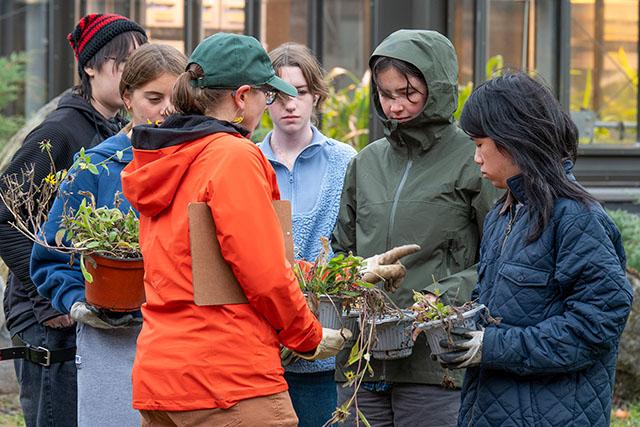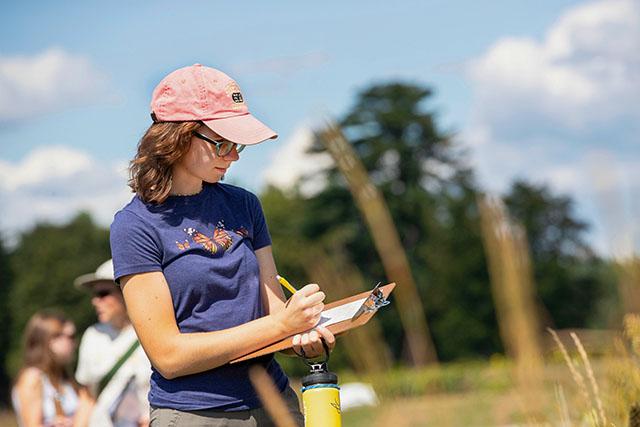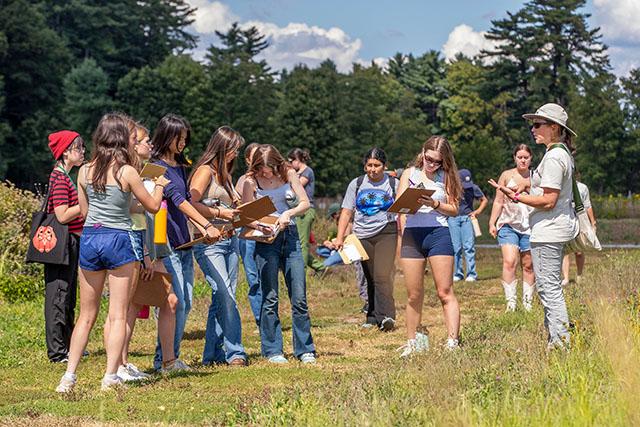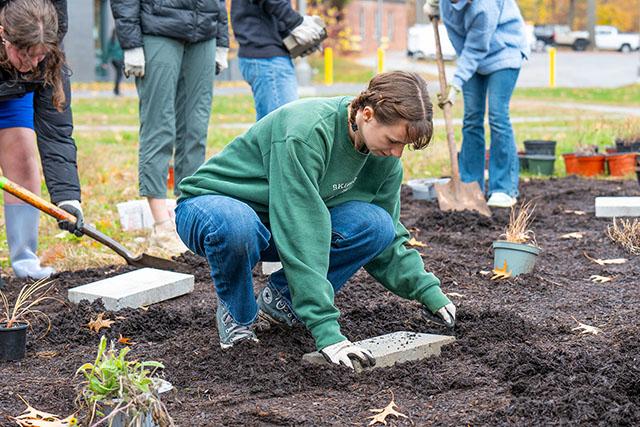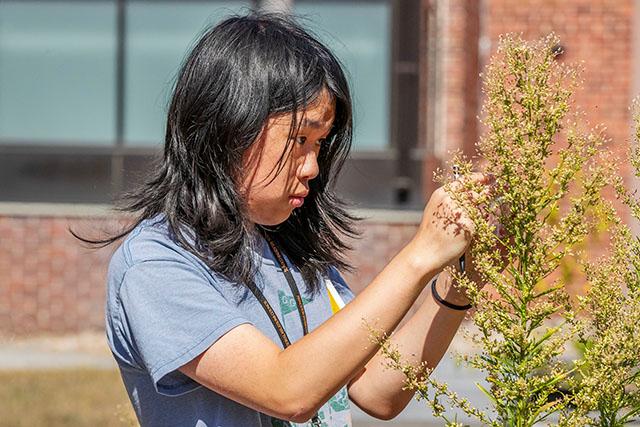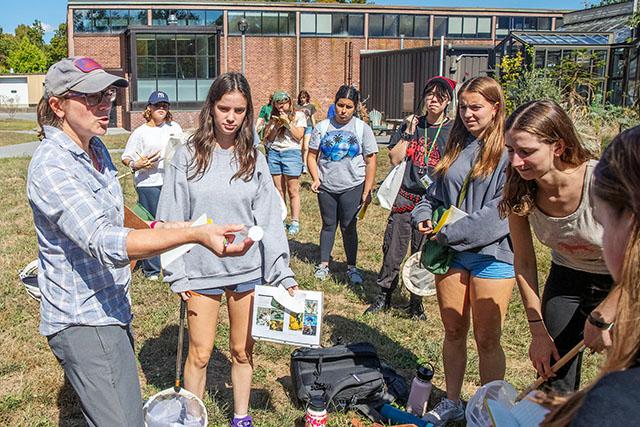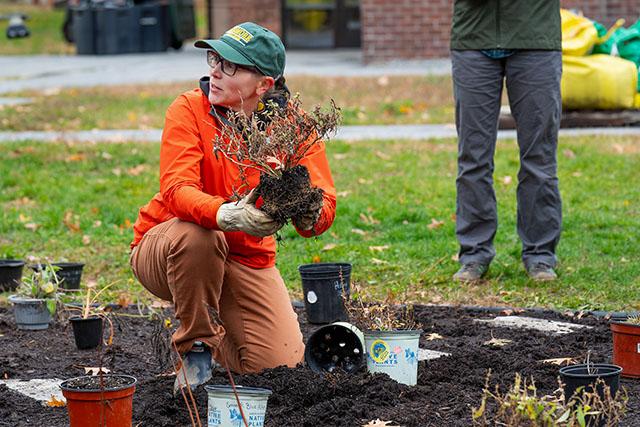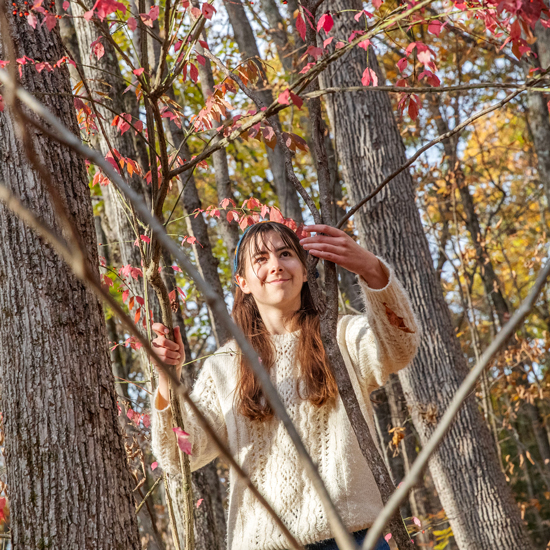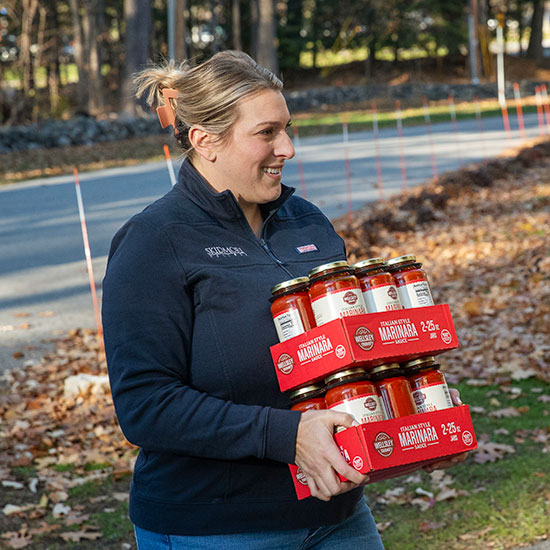Getting our hands dirty and watching ideas grow in our first-year seminar
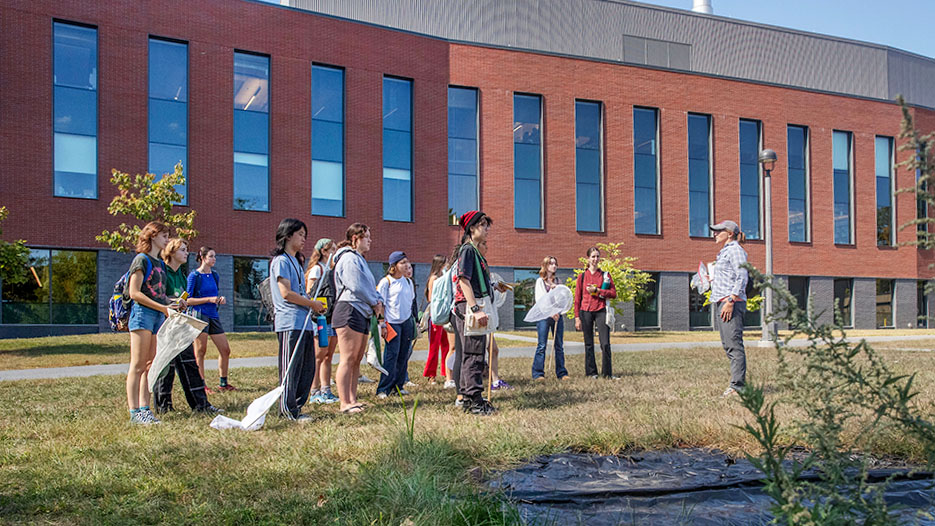
“I caught a bee!” one of my first-year students exclaims. She holds out the clear plastic vial and sure enough, there at the bottom is a small, dark insect that looks very different from the fuzzy, black and yellow-striped honeybee that many of us would picture.
The students are part of my first-year Scribner Seminar, Pollinators in Peril. They’ve been learning how to distinguish bees from other similar-looking insects like wasps and flies, and this specimen has all the characteristics of a bee: long antennae, a stocky body, and eyes on the sides of its head. We’re surveying insects around the site of a future pollinator garden that the students designed and eventually planted this fall.
Small, interdisciplinary seminars like mine are a cornerstone of Skidmore’s First-Year Experience. They’re designed to give incoming students a rigorous and engaging introduction to college academics, but they’re also a place to explore new ideas, ask questions, and build community.
Jaidaly Cruz ’29, a QuestBridge scholar, describes her experience in my Scribner Seminar during her first semester at Skidmore.
All first-year students take a Scribner Seminar. All the seminars reflect Skidmore’s ethos that Creative Thought Matters, but topics vary widely. This fall’s seminars range from How to Change the World in 15 Weeks to Japanese Animation. Two are even held in London.
One of the things that fellow faculty and I especially appreciate about teaching these seminars is the opportunity to design a course around a subject that excites us. Regardless of the topic, we share common goals — helping students learn to conduct independent research, critically evaluate sources of information, and craft evidence-based arguments.
Scribner Seminars also help our students transition to college life. Each week, our seminar’s trained peer mentor, Rachel Entin-Bell ’27, leads discussions on topics from academic integrity to mental health and wellness — giving students tools to thrive both in and beyond the classroom.
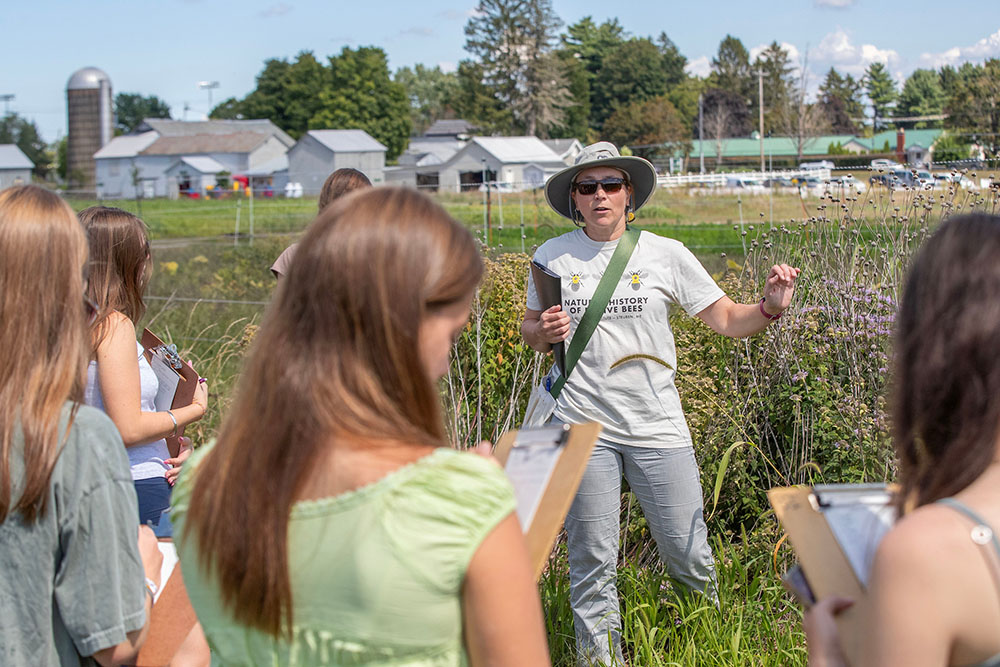
Field trips this semester, including this one to Pitney Meadows Community Farm (about 3 miles from campus), allowed me to show students a successful pollinator garden and to envision our own on campus.
Learning by doing
As a biologist, I wanted to design a first-year seminar that let students tackle an environmental problem and, in the process, connect deeply with campus and the local community.
Native insect populations have plummeted in the U.S. and around the world, threatening agricultural crops, native plants, and animals that depend on insects for food. One major culprit is habitat loss. Pollinator gardens can help counter this by providing essential feeding and nesting sites.
Our seminar introduces some basic biological knowledge: How do plants reproduce? Which species of plants are most useful to native pollinators?
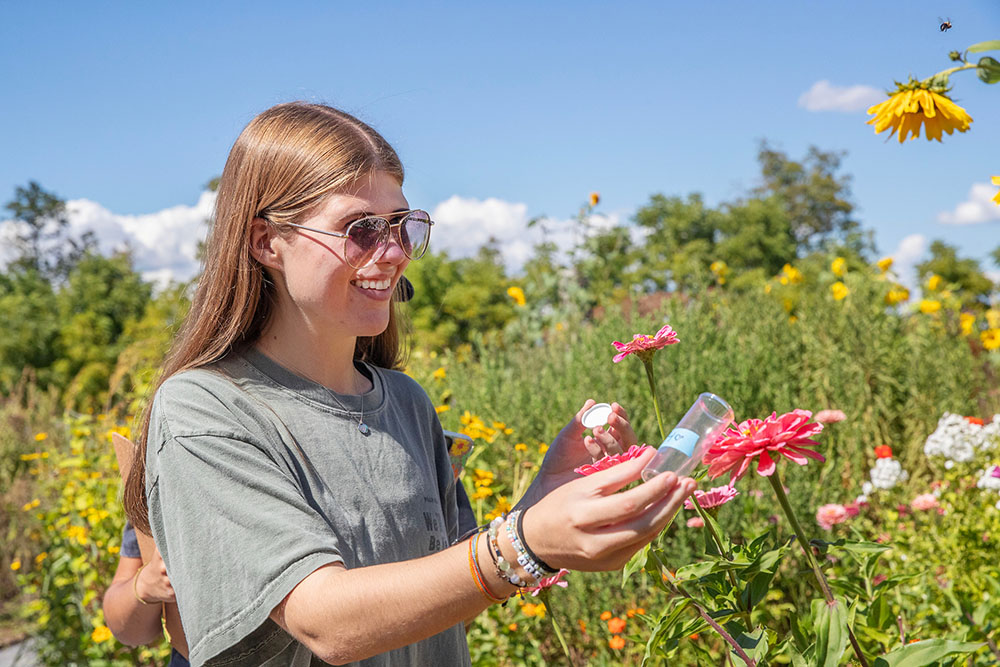
Experiential learning is a key component of our Scribner Seminar. Here, Callan Balsis ’29 captures a bee at Pitney Meadows Community Farm as part of our seminar’s efforts to understand local pollinators.
But this course also provides the opportunity to think more broadly about ideas like the cultural roles of gardens. To explore these ideas, students are reading essays and chapters and viewing short documentaries from the fields of psychology, education, and art.
These diverse approaches recognize that while some of my students plan to major in biology, others will study subjects ranging from music to management and business. Some of my students already know what they plan to study at Skidmore; many do not. And I’ll be there to guide them along the way.
A work in progress
The garden began taking shape long before students arrived on campus for the fall. Last winter, student volunteers and even some preschoolers helped me create mini greenhouses out of empty milk jugs that we filled with soil and native plant seeds. The jugs sat outside in the cold, mimicking the natural conditions under which native plants develop.
In June, I laid down a black plastic tarp to kill grass and make way for our future garden.

Ashley Cardona ’29, left, and Cecilia Cangiano ’29 take notes at Pitney Meadows on species of native plants as first-year students consider what plants to include in our campus pollinator garden.
By the time students arrived on campus, the site didn’t look very impressive. Shallow pools of water had gathered in slight depressions and dried to leave behind a film of dirt, and an exuberant tuft of crabgrass erupted from a tear in the sheeting. It required some imagination to envision this as the site of a thriving garden buzzing with insect life.
Our College has made sustainability a top priority — in terms of teaching and learning
and in terms of the concrete steps we’re taking in our energy use, buildings, and
conservation on campus.
And so Skidmore’s Office of Sustainability has been a key partner in this project. In class a few weeks after our insect surveys,
Tarah Rowse, director of sustainability and environmental initiatives, provided an
overview of campus landscape sustainability efforts and emphasized how our garden
embodies these efforts.
“We have a campus as a living lab, and your class is a perfect example of that,” Rowse told my students.
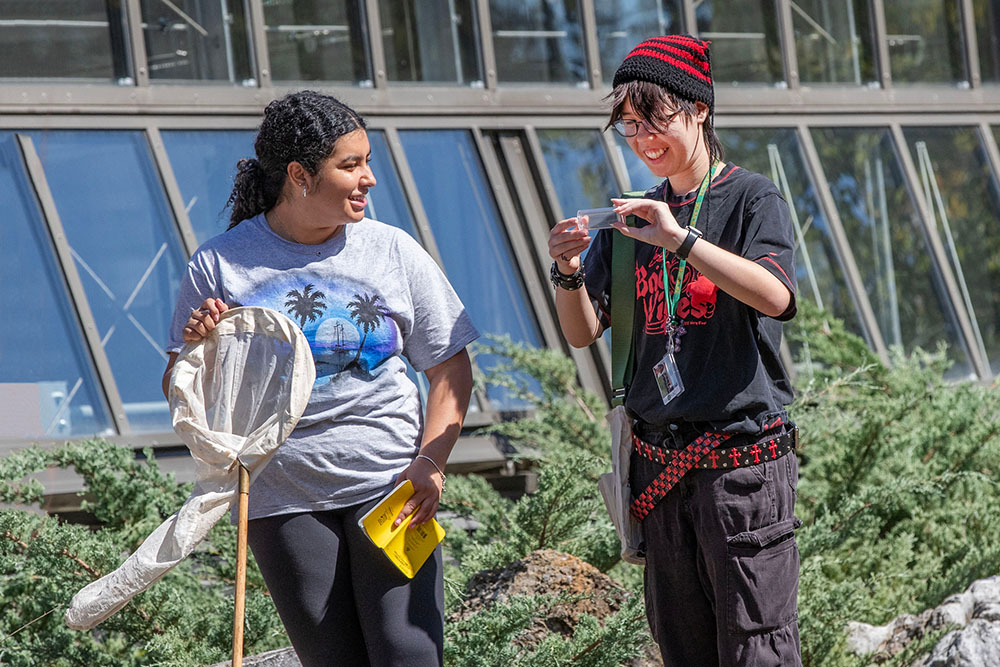
Ashley Cardona ’29, left, and Vanessa Tang ’29 smile as they examine an insect they captured as part of our seminar’s inventory of pollinators at the site of our future garden, outside the greenhouse of the new Billie Tisch Center for Integrated Sciences.
In addition to understanding how their work fits within campus sustainability efforts, I also wanted students to see how this project aligns with broader community efforts to protect native pollinators.
Early in the semester, we piled into campus vans and drove across town to visit two local pollinator gardens. These gardens provided models of what thriving pollinator gardens can look like — an opportunity to observe their insect visitors and learn about the particular goals, challenges, and successes of each garden.
Getting our hands dirty
We finally gather to plant our garden on Halloween. It’s barely 50 degrees (Fahrenheit), and strong winds are shoving ragged clouds across the sky. After weeks of planning, it’s time to get our hands dirty. We’ve discussed basic garden design principles in class, but there’s no substitute for actually setting out the plants, evaluating, and then adjusting.

Heavy rain during our field trip to the SoBro Conservancy (an urban pollinator garden on South Broadway in Saratoga Springs, less than 2 miles from campus), made the experience even more memorable for students, including Callan Balsis ’29, left, and Maya Willenbring ’29.
We place the pots of seedlings in tentative locations — first the buttonwood shrubs and New York ironweed as our tallest layer, then species like hairy beardtongue, mountain mint, and dense blazing star arrayed around them. We add two walkways of paving stones, arrange shorter species like pearly everlasting and columbine near the front, and intersperse the grasses. When we’re happy with the layout, most of the students start planting, while a few circulate and add labels.
When we finish, most of the students are muddy but smiling. The garden contains 16 different species and more than 60 individual plants — not only the seedlings that the students have been caring for all semester, but additional species that they researched and selected.
All of the plants will advance the ecological and social goals the students have chosen for the garden: supporting native bees, moths, and butterflies; facilitating education; and fostering mental health.
To be honest, most of the plants don’t look fantastic right now. This late in the fall, they’re going dormant, with brown stalks and shriveling leaves.
When we first gathered this afternoon, I told the students that gardening is an act of faith. The true payoff for all their planning and hard work won’t really come until the spring.
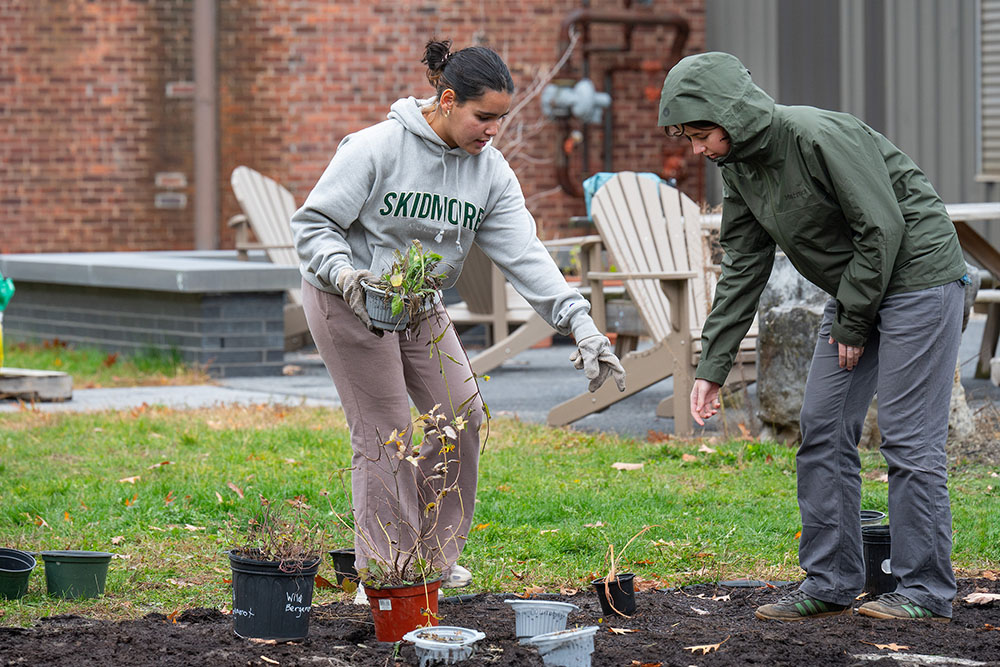
Planting was a highlight of the semester. Here, Jaidaly Cruz ’29, left, works with our seminar’s peer mentor, Rachel Entin-Bell ’27, on the big (albeit muddy) day.
What many of them probably can’t yet imagine is how different the garden will look not only a year from now, but three, as they enter their senior year. Although it’s not listed in our learning objectives, this is one of the lessons that I hope they take away from this course: new projects can be challenging and uncomfortable, and they can take time.
That’s true for gardening, but also for finding your social group on campus or choosing a career path. My hope is that we will gather here again before they graduate, to say: Look how much has changed. Look how much has grown and blossomed and developed over these four years.
Erika Schielke is a teaching professor of biology at Skidmore College.
